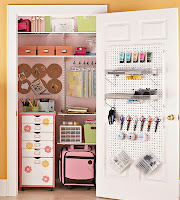Tips for Tuesday
 We’ve all seen storage racks for the
door. They can be used for shoes in your
closet or mud room. They can be used to
hold towels in the bathroom or spices in the pantry. But there are many more uses for door storage
if you think outside the box.
We’ve all seen storage racks for the
door. They can be used for shoes in your
closet or mud room. They can be used to
hold towels in the bathroom or spices in the pantry. But there are many more uses for door storage
if you think outside the box.
For example, those shoe pockets come
in handy for flip flops, but how about using it for hair accessories, small
stuffed animals or socks for your child. And those pantry racks are useful for canned
goods, but they can hold paperback books, DVDs or accessories in your teen’s
room.
Here are more ideas for over-the-door
storage:
·
Several towel bars
can hold extra blankets and linens.
·
Hooks can hold
purses and handbags

·
Small hooks
inside a cabinet can hold measuring spoons.
·
Use pockets for a
family communication center--mail, mp3 players, notepads,dog leashes, etc.
·
Use pockets
inside your pantry to hold spices, small bags of food, plastic bags, etc.
·
Use a rack for
giftwrap storage.
·
Use a rack or
pockets for craft supplies.
·
Use “S” hooks to
hold umbrellas.
What have you stored on your
door?







